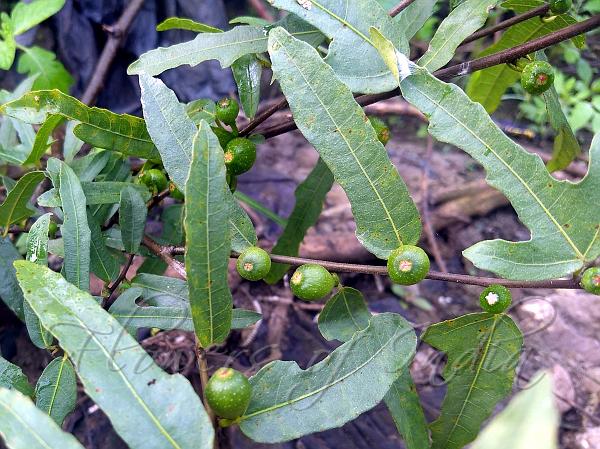|
| Creeping Fig |
|

|

| File size | 1070152 |
| Original date | 11/20/19 8:49 AM |
| Resolution | 3264 x 2448 |
| Flash | Flash did not fire, auto |
| Focal length | 4.28mm |
| Exposure time | 1/100s |
| Aperture | 1.7 |
| Focus Distance | |
| Metering Mode | Center weighted average |
| Camera make | motorola |
| Camera model | Moto G (5) Plus |
| Sensor type |
|
|
|
|
Photo: |
Botanical name: Ficus heterophylla Family: Moraceae (Mulberry family)
Synonyms: Ficus cannabina, Ficus aquatica, Ficus repens
Synonyms: Ficus cannabina, Ficus aquatica, Ficus repens
Creeping Fig is a large prostrate shrub with milky
sap. Leaves are alternate, elliptic-oblong, young ones pinnately 5-7
lobed, 5-7 by 2-3 cm, base rounded, margin sawtoothed, tip tapering,
3-nerved from base, lateral nerves 5-7 pairs, rough, thin-leathery.
The fact that the plant generally sports two different kinds of leaves
led to its species name heterophylla.
Figs are borne singly in leaf-axils, dioecious, broadly ellipsoid, about 1 cm
across; basal bracts ovate, closed by 4-6 apical bracts; tepals 3,
linear-lanceate. Male flowers are in 2-3 series, stalked; stamen 1.
Female ones are stalkless; ovary ovoid. Achenes are shortly ellipsoid, surface
with a transparent membrane. Creeping Fig is found in moist areas, near
rivers and streams, from India to China (S. Yunnan, Guangdong) and W. Malesia.
Flowering: July-November.
Medicinal uses: The leaf paste is applied for
several days as a poultice on areas affected by rheumatism or on ear
infections.
The leaf paste is applied for
several days as a poultice on areas affected by rheumatism or on ear
infections.
Medicinal uses:
 The leaf paste is applied for
several days as a poultice on areas affected by rheumatism or on ear
infections.
The leaf paste is applied for
several days as a poultice on areas affected by rheumatism or on ear
infections. | Identification credit: Revati Gindi | Photographed along Mula river, Pune. |
• Is this flower misidentified? If yes,